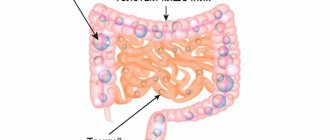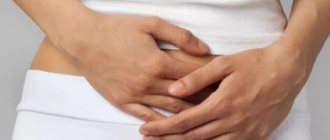Gas formation in the intestines is a common symptom experienced by patients with dysbiosis, diseases of the gastrointestinal tract, and nutritional disorders. The disorder occurs in people of all age groups: newborns, adults, pregnant women, nursing mothers, and the elderly. It is recommended to refrain from self-medication and identify the underlying factor causing flatulence. Symptomatic therapy blurs the clinical picture and makes it difficult to make an accurate diagnosis.
What it is
The human intestine contains more than 180 ml of gaseous substances. They are formed when food breaks down. Sulfur, nitrogen, carbon, methane are released. When stomach acid and pancreatic juice of the pancreas begin to interact, carbon monoxide is produced. Air masses also enter the body during swallowing.
Air enters through the rectum during belching. Gas exchange depends on the tone of the abdominal muscles and diaphragm, and intestinal motility. With excessive density of feces, metabolic processes are disrupted, and increased gas formation in the intestines is observed. The release of gas is a natural process that normally occurs in a healthy person up to 20 times during the day and night.
Causes of gas formation in the intestines in women and men
Gas formation is a completely natural process that occurs in the intestines of both women and men. But increased gas formation is already a deviation and requires immediate action.
There are processes in which excessive swallowing of air occurs:
- Hasty intake of food or liquid.
- Chewing gum.
- Smoking.
- Drinking carbonated drinks.
- Pulling air through the gaps between teeth.
Frequent strong formation of gases in men and women can be caused by disruption of the gastrointestinal tract. This constant disruption of digestive processes may be due to the following factors:
- insufficient secretion of digestive enzymes;
- the presence of peptic ulcer and gastritis;
- weakening of digestive functions;
- insufficient development of the digestive system in infancy; about 70% of newborn babies face this problem.
- consumption by a woman of foods that cause gas formation during breastfeeding;
- improper attachment of babies to the breast, which leads to swallowing air;
- impaired peristalsis due to consumption of large amounts of protein foods with a sedentary lifestyle;
- the occurrence of hormonal disorders and disruptions in the body;
- increased gas formation may be a consequence of genetic abnormalities.
People at risk of developing gas in the intestines:
- those who abuse smoking, alcohol, carbonated drinks, sweet foods, and baked goods;
- eating improperly, on the run, on dry food;
- not following a diet;
- constantly swallowing air when eating or drinking;
- those who abuse high-carbon foods;
- often taking beans and beans.
If increased gas formation is a consequence of taking antibiotics, resulting in the death of beneficial intestinal microflora, it is necessary to increase the use of fermented milk products containing bifid additives.
Symptoms
Flatulence can be fermentative and putrefactive. Both forms manifest themselves in the form of diarrhea, which alternates with constipation, gases with an sour or hydrogen sulfide odor. Symptoms intensify after consuming carbohydrates, dairy products, fiber, and foods rich in protein. Increased gas formation is accompanied by belching, pain in the abdominal area, excessive discharge of gases, bloating, and hiccups.
There are complaints of nausea, disturbances in stool and appetite, difficulty defecating, and bad breath.
- Patients describe a feeling of fullness and discomfort in the abdominal cavity, an enlargement of the abdomen.
- The pain is dull, aching, radiating to different parts of the gastrointestinal tract.
- Gas colic is accompanied by painful, cramping attacks.
Flatulence develops - excessive release of a large amount of digestive gases, after which the patient feels relief.
Choose a specialist and make an appointment with a gastroenterologist online
Folk remedies for the treatment of gas formation
It makes sense to use traditional medicine if there are no serious gastrointestinal pathologies, or as an adjuvant to the main treatment. To reduce the production of gases in the intestines, the following are effective:
- Peppermint or lemon balm decoction at the rate of 2 tsp. per glass of boiling water - take ½ glass before meals.
- Anise, fennel or cumin seeds - chew 4-5 pieces after meals.
- Licorice root decoction - 1 tsp. for 250 ml of water, cook for 15 minutes, drink 1/3 cup before meals.
- Dandelion Roots - Use in a similar way to licorice.
- Infusion of parsley roots - 1 tbsp. l. pour 400 ml of hot water and leave for 24 hours, take 100 ml twice a day.
Teas with chamomile, rowan, and ginger have also proven themselves well.
Nutrition for increased gas formation
When experiencing flatulence, it is important to pay attention to the foods included in your diet. Gas formation in the intestines is caused by many of them, but first of all you should exclude legumes, all types of cabbage, apples, carbonated drinks, including kvass and beer, dark bread, onions, spinach, simple carbohydrates (sugar, sweets, baked goods).
Other recommendations:
- Prepare food by steaming, boiling or baking, avoiding fried foods;
- Do not combine protein and starchy foods, for example, potatoes with meat or eggs, buckwheat porridge with milk;
- Do not overeat - small portions are digested much faster;
- Eat more dairy products while taking antimicrobial medications.
Excess intestinal gases can be caused by both dietary errors and diseases of the digestive system. Therefore, to effectively combat this unpleasant symptom, do not be too lazy to visit a gastroenterologist and find out the true cause of increased gas formation.
Tags: intestines, nutrition
- Erectile dysfunction - causes and treatment,...
- Male infertility - types, causes and treatment, drugs
- Atrial fibrillation - causes, symptoms and...
- Glaucoma - causes, symptoms and treatment, disease prevention
- Retinal angiopathy, what is it? Types, reasons and...
- Scoliosis - causes, symptoms by degree, treatment,…
Types of flatulence
Flatulence can be acute or chronic. Acute forms may indicate peritonitis, dynamic, paralytic and mechanical intestinal obstruction. The chronic course is promoted by aerophagia, neuroses, impaired salivation, and the use of chewing gum. Depending on the cause that provoked the symptom, flatulence can be:
- Nutritional – occurs when consuming foods that produce a large volume of gases. These include cellulose, hemocellulose, pectin, and coarse fiber.
- Psychogenic – observed in patients with stress and psychological disorders.
- Dynamic – occurs when there are disturbances in the transit functions of the gastrointestinal tract. The free movement of gas slows down significantly.
- Digestive – caused by digestive disorders: absorption and circulation of bile, food intolerance.
- High altitude - develops when rising to a high altitude, when the gas expands and pressure increases.
- Dysbiotic – progresses in patients with intestinal microflora disorders.
- Mechanical – observed in patients with evacuation disorders of the gastrointestinal tract that impede motor activity: the formation of adhesions, neoplasms, strictures.
- Circulatory – caused by blood circulation disorders: high blood pressure, congestion, ischemic lesions affecting the large intestine.
Taking into account the type of disorder, the doctor selects an appropriate treatment regimen.
What is the reason?
Flatulence is observed in practically healthy people when overeating or consuming foods whose digestion causes increased gas formation.
Another reason for the accumulation of gas in the small intestine can be the result of several medical and genetic problems, such as celiac disease (gluten intolerance) or inflamed bowel disease. In these cases, anatomical abnormalities occur in the intestinal wall, which cause a slowdown in the digestive process and gas absorption.
Sometimes “stress flatulence,” that is, excessive “talkativeness” of the intestines, is provoked by nervous situations that “awaken” stress hormones. Some experts even call irritable bowel syndrome “gut depression.” Interestingly, clinical depression and “gut depression” exhibit the same hormonal imbalance.
Causes
Impaired intestinal motility caused by swallowing a large portion of air, intoxication, scleroderma, connective tissue pathologies, and surgical interventions. Increased gas formation is often observed with intestinal dysbiosis. Among the predisposing factors causing excess gas production are:
- anxiety states, nervous tics, stressful situations
- violations of rules and diet
- impaired intestinal motility
- overgrowth of bacterial microorganisms that produce gases
- increased pressure in the gastrointestinal tract during ascent to high altitudes
- production of excess gases: malabsorption syndrome, maldigestion, food abuse
- mechanical damage that disrupts the excretory function of the intestine
- insufficient activity of carbon dioxide transport, which occurs with right ventricular failure
- helminthic infestation followed by a decrease in the absorption area
Airbrushing occurs when you are in a hurry while eating, smoking, talking while eating, drinking carbonated drinks, eating caramels, chewing gum, or using unsuitable dentures. Products with increased gas-forming potential include dried fruits and beer. Flatulence is observed with increased consumption of onions, mushrooms, celery, cruciferous vegetables (various types of cabbage, radishes), cucumbers, carrots, fruits, yeast baked goods, legumes, and grain crops.
Flatulence occurs in people who abuse fatty foods. Eating up to 2 times a day, in large portions, causes increased stress on the colon and gastrointestinal tract. Digestive disorders are often observed in people with a history of enzyme deficiency, dysfunction of the enterohepatic bile circulation, and dysbiosis.
Poor blood circulation in the intestinal area
In case of digestive disorders in the gastrointestinal tract, the large and part of the small intestine suffers from limited blood circulation. The esophagus, rectum and stomach are less susceptible to this disorder. Ischemia develops in the colon, symptoms decrease within 24-72 hours, and after a few weeks the patient recovers completely. The development of acute mesenteric anemia is observed with insufficient blood circulation in the small intestine.
The disease develops due to embolism or thrombosis of the intestinal arteries and progresses in patients with atherosclerosis. In rare cases, the disorder is accompanied by endocarditis, intestinal obstruction, and inflammatory processes in the blood vessels. Circulatory disorders in the intestines manifest themselves:
- vomiting
- sudden severe pain in the abdominal area
- colic in the stomach
- flatulence
- weight disorders
- loose stools
- increased anxiety
Treatment is surgical. In case of intestinal infarction, immediate emergency medical care is required.
Some medications
Increased gas formation is observed in patients who are recommended to take:
- narcotic analgesics
- medications for diarrhea: Immodium, Loperamide
- additives containing psyllium husk or coarse plant fiber
- iron preparations. Bivalent iron acts faster, but is poorly absorbed by the body, and most often there are adverse reactions from the gastrointestinal tract. Ferric iron acts more slowly but is better tolerated. It is recommended to use modern, chelated formulas. For better absorption, be sure to additionally take co-factors: B vitamins, copper, manganese, silicon, chromium.
Before starting to use the medicine, carefully study the instructions, paying attention to possible side effects. If there are objective indications for taking a medication that causes bloating, discuss with your doctor the possibility of using corrective agents to reduce adverse reactions: Espumisan, Simethicone.
Dysbacteriosis and biocenosis
Dysbacteriosis and biocenosis cause flatulence in more than 50% of patients. Such a disorder occurs as a result of enzymatic, lactase deficiency, due to the use of antibiotics, and food intolerance. Dysbiosis is one of the links that occurs in people with food allergies, inflammatory diseases of the gastrointestinal tract, and antibiotic-associated diarrhea.
With normal microflora the following is observed:
- stimulation of immune status
- regulation of lipid metabolism
- support of metabolic and enzymatic processes
- providing antitoxic, antimutagenic, anticarcinogenic effects
Treatment of dysbacteriosis and biocenosis is complex. Includes diet, taking probiotic drugs: probiotics, prebiotics, syn-biotics.
Adhesions in the gastrointestinal tract
Adhesive processes form in the gastrointestinal tract after surgery, against the background of inflammatory processes. Accompanied by gluing of intestinal loops, disturbances of peristalsis, a feeling of discomfort, and flatulence. A similar complication can accompany childbirth and infectious diseases. It occurs due to violations of the integrity of the peritoneum and manifests itself in the form of:
- nagging pain in the abdominal area, which intensifies after physical activity
- dyspeptic disorders: bloating, diarrhea, increased gas formation;
- prolonged constipation
- intestinal obstruction
To confirm the diagnosis, a blood test is performed, contrast radiography is performed, and ultrasound diagnostics are performed. Additionally, diagnostic laparoscopy of the intestine is indicated. During therapy, conservative and radical methods are used. Conservative treatment is aimed at reducing the inflammatory reaction and restoring the functional state of the affected organs. They follow a diet and fasting is prohibited. If ineffective, surgery is indicated.
Pancreatitis
Pancreatitis is an inflammatory process that affects the pancreas. It is observed in patients with diabetes mellitus and is accompanied by complaints of constant, paroxysmal pain and flatulence. The absorption of food from the intestines is disrupted, and deficiency conditions develop that need to be corrected in a timely manner. In the chronic form of the disease, exacerbations alternate with remissions.
Mild to moderate course of the disease is accompanied by regular pain; progression leads to diarrhea and the release of excess fat in the feces. Body weight decreases, pain radiates to the left and right hypochondrium. Nausea, flatulence and vomiting worsen after the use of medications that inhibit the functioning of the pancreas (for example, narcotic analgesics).
Irritable bowel syndrome
Irritable bowel syndrome develops against the background of dysbiosis, irregular and balanced nutrition, a sedentary lifestyle, and sedentary work. The risk group consists of people with a genetic predisposition and hormonal imbalances. IBS occurs in people who abuse alcohol, carbonated drinks, fast food, chocolate, caffeine-containing foods, cookies, refined foods, and fatty foods.
Irritable bowel syndrome causes complaints of bloating, constipation, diarrhea, and abdominal pain. Discomfort occurs after eating food and is eliminated after bowel movement. The pain is cramping, spastic, alternates with aching and stabbing.
Gastritis and peptic ulcer, colitis
Gastritis, gastric ulcer and colitis are accompanied by frequent bowel movements, flatulence, diarrhea, and abdominal pain. Treatment is selected depending on the degree of progression of the pathological process and the presence of associated complications. Diet is an important element of therapy. Avoid fatty, fried, spicy, heavy foods, spices, refined foods, and simple carbohydrates.
Nervous overstrain
Nervous tension is a manifestation of stress, which manifests itself in the form of disturbances in the regulation of digestion. There are complaints about the development of flatulence, bloating, belching, nausea, and cramps. The stool and reflux are disrupted - the reflux of acid from the stomach into the esophagus. The intestines are irritated, and gastrointestinal dysfunction is observed.
In addition to digestive disorders, there are complaints of increased sweating, rapid heartbeat, internal trembling, increased irritability, anxiety, and sleep disturbances. To reduce nervous tension, physical activity, breathing exercises, and the use of sedatives are indicated. The lack of timely treatment is fraught with dysfunction of the immune system and cardiovascular disorders.
Helminthiasis
Helminthiasis is a parasitic disease that is accompanied by a protracted, long-lasting course and a wide range of clinical manifestations. Occurs under the influence of round and tapeworms, flukes. Ascariasis is accompanied by dyspeptic syndrome: flatulence, nausea, vomiting, weight problems, unstable stools, and a tendency to constipation. The skin around the anus becomes red and swollen, allergies and bronchopulmonary syndrome occur. Treatment is carried out with the help of anthelmintic drugs and liver cleansing drugs.
Polyps and tumors in the intestines
Polyps and tumors are asymptomatic and affect the inner mucous membrane of the intestine. Most often they affect the large intestine, occurring in 14-17% of patients. The dimensions do not exceed 1 cm. Single formations are observed, more often the formation of small groups. The disease is often detected accidentally during a routine examination.
Sometimes polyps and tumor formations appear:
- rectal bleeding
- flatulence
- long-term constipation and diarrhea
- pain in the abdominal area, nausea, vomiting
Laboratory tests indicate iron deficiency anemia, which occurs due to internal bleeding and impaired absorption of iron in the gastrointestinal tract. The only treatment option is surgery. A polypectomy is required, which is performed during examination of the large intestine.
Causes of increased gas formation
Content
Not only is flatulence itself an unpleasant condition, it can also be accompanied by symptoms such as heartburn, belching, hiccups, diarrhea or constipation, a nasty taste in the mouth, and the urge to pass gas (flatus). Why does this whole “bouquet” arise? The causes of flatulence are non-pathological and pathological. The first include:
- eating foods containing excess carbohydrates, which provoke fermentation and the formation of gases;
- lactose-containing products in case of lactose intolerance in a person are milk and everything that is made from it;
- irregular meals with long breaks;
- careless chewing of food, swallowing it in large pieces;
- swallowing air while eating;
- unreasonably frequent use of enemas.
It is enough to exclude dishes that provoke flatulence from your menu, start monitoring the speed of food absorption and the thoroughness of chewing it, drink enough liquid - and everything will return to normal. But there are pathological causes of flatulence. And there are not so few of them.
The intestines are a real hostel for trillions of microorganisms! They play an important role in digestion and metabolism in general, and are also involved in the functioning of the immune system. Not only are there beneficial inhabitants in the gastric tract, pathogenic microflora is also present in a certain concentration. But in healthy people, its content is controlled by the body. Once this balance is disrupted, the beneficial part of the bacteria begins to retreat before the increasing army of pathogens. Against the background of this situation:
- dysbacteriosis appears;
- existing chronic gastrointestinal diseases worsen;
- acute infections occur.
Intestinal bloating and severe gas formation also appear in cases of impaired gas discharge due to obstruction or atony of the gastrointestinal tract. Nervous disorders, diets, and antibiotic treatment provoke dysfunction of the digestive organs, hence flatulence. Increased gas formation can also be caused by parasites – helminths that live in the intestines.
By the way, read more on this topic: Heaviness in the stomach after eating - causes and treatment
Foods that cause bloating
If you are intolerant to certain foods or improperly prepared, flatulence may develop. Most often, bloating is preceded by the use of:
- legumes: chickpeas, lentils
- cruciferous: cauliflower and white cabbage, radish, radish, arugula, broccoli
- fermented milk products, cow's milk
- cereals high in gluten
- fresh yeast baked goods
Plant products: cereals, legumes, seeds contain phytic acid, which slows down the absorption of beneficial micronutrients and can cause flatulence. To prevent its development, it is recommended to soak bobos overnight with ½-1 teaspoon of soda. The next morning, drain the water and cook the product until done.
Bloating when eating different types of cabbage is often observed in the absence of enzymes to digest fiber. It may take from 2-3 months to six months for the microflora to form. If you are intolerant to a product, for example, cow protein or gluten, in addition to flatulence, there are complaints of deterioration in general health, weakness, diarrhea, nausea, and vomiting. To determine food tolerance, it is recommended to take a blood test and eliminate inappropriate foods from the diet.
Diagnostics
To make an accurate diagnosis, an objective medical examination is performed and radiography is used. Tapping the abdominal area is accompanied by tympanic sounds. Additionally, it is recommended to:
- General analysis of urine, blood
- examination of stool, which reveals iodophilic flora, starch grains, connective tissue, muscle fibers
- N-2 breath test to determine hypolactasia, bacterial overgrowth
- ultrasound diagnostics
- magnetic resonance imaging
The absorption function is checked: fatty formations in the stool are determined, tests are carried out with D-xylose.
Treatment
Treatment is aimed at eliminating the root cause causing bloating. In case of eating disorders, a diet is recommended. Products that have a low gas-forming potential are introduced into the diet. It is recommended to consume citrus fruits, hard cheeses, bananas, non-carbonated drinks, and dietary meat. Leave fermented milk products with bacterial (not yeast) leaven and cereals. To determine the tolerability of a particular product, you can take a blood test in the laboratory. Potential triggers of flatulence are also removed from the diet one by one and the body’s reaction is observed. Avoid the use of:
- dairy products
- yeast
- legumes
- soda
- refined sugar
If the cause of bloating is swallowing excess air, it is recommended:
- eat food slowly
- refrain from talking during meals
- do not consume chewing gum, caramels
- do not use a straw when drinking liquid, avoid beer, soda
- quit smoking
- consume sweet fruits and berries, dessert, observing the interval: at least 60-120 after the main meal
If flatulence is not caused by a pathological condition, moderate physical activity is indicated: walking in the fresh air, strengthening the abdominal muscles, yoga, gymnastics, self-massage. In other cases, the gastroenterologist selects a treatment protocol, taking into account the underlying factor of flatulence, accompanying symptoms, and individual characteristics of the body.
The general scheme of drug therapy involves the use of:
- Enterosorbents: Enterosgel, Diosmectite, Activated carbon, Plifepan. Active substances bind and remove toxic substances that produce increased gas formation.
- Defoamers are drugs based on simethicone, which convert gaseous substances into foam and reduce the surface tension of gas bubbles. The drugs of choice are Espumisan, Espusin, which prevent the formation of gas bubbles, eliminate the feeling of heaviness and bloating. Suitable for adults and children, patients with metabolic and hormonal disorders.
- Non-pancreatic enzymes that help digest carbohydrates.
- Carminatives: fennel fruits, dill, caraway seeds, valerian rhizomes, mint.
Diet, physical activity, and treatment of the psycho-emotional state are mandatory elements of complex therapy.
Treatment of severe gas formation in the intestines
Treatment of increased gas formation begins only after the cause of this condition has been determined. Etiotropic, pathogenetic and symptomatic therapy is used.
The use of enzyme substances is widespread, as they naturally improve digestion - due to a greater supply of bile and gastric juice to break down foods.
When, during the diagnosis, it is determined that gases accumulate due to the use of any medications, it is necessary to treat by discontinuing such medications or switching to lower doses. The doctor’s actions will depend on the intensity and severity of the disorder.
In some cases, taking medications is not enough, and the pain does not go away. This may indicate the presence of other serious diseases:
- in women - rupture of an ovarian cyst;
- intestinal obstruction;
- attack of appendicitis;
- peritonitis.
Medicines for gas formation
- Defoamers. These substances, affecting the surface tension of air bubbles, lead to their destruction. For example, Espumisan, Antiflat.
- Enterosorbents. They have the ability to adsorb gas bubbles and residual products that linger in the intestines undigested. The main component of these drugs is Activated carbon. It actively absorbs all excess gases from the intestines. Medicines produced using diosmectite or lignin have a similar effect. Taking these medications should be accompanied by mandatory consultation with your doctor, as they can stimulate the formation of constipation in the body.
- Smectites. They also have the ability to adsorb gases, toxic metabolites, and bacteria. Preparations based on lignin. Polyphepan, Entegnin.
- Antispasmodics (No-shpa, Spasmol).
Taking adsorbents and antispasmodics improves your well-being within 20-40 minutes. Pain from flatulence goes away immediately after bowel movement or passing of gas. If after these measures the patient continues to complain of severe abdominal pain, then this may indicate a serious illness:
- attack of acute appendicitis;
- peritonitis;
- intestinal obstruction;
- rupture of an ovarian cyst.
If, due to excessive gas formation, it is not possible to take medications that normalize the functioning of the gastrointestinal tract, you can also use traditional behavioral methods of preventing flatulence:
- Drink clean water regularly, but only in recommended quantities.
- Never rush when eating. Poorly chewed food is one of the main causes of severe gas formation.
- Do not eat baked goods or carbonated drinks.
Recommended Exercises
You can fight pain from gases in the intestines with the help of “gymnastics”. Perform as needed and for prevention. Common exercises:
- Tighten and then relax your bloated belly. 10-15 repetitions.
- Pull your legs towards your body while lying on your back and release the air. Do 1-2 minutes.
- Lie on your back, bend your legs. Exhale, massage your stomach with your palms, inhale again. Do 5-7 times.
To feel good, it is not enough to quickly cope with unpleasant sensations. You need to figure out the cause of intestinal dysfunction - it will take time, but the result is worth it.
If the symptoms of gas formation in the intestines do not go away for a long time, serious diseases and even tumors in the intestines can develop in the gastrointestinal tract, when the treatment of gases in the intestines will need to be carried out through surgery.
Prevention
To prevent increased gas formation, it is recommended to review your diet and maintain a drinking regime. Treat chronic diseases of the gastrointestinal tract and inflammatory processes in a timely manner. Restore intestinal microflora: eliminate candidiasis, use suitable probiotics to populate beneficial microflora.
At the first signs of gas formation, exacerbation of chronic diseases, inflammatory processes and changes in microflora in the gastrointestinal tract are excluded. Next, adjust the diet, maintain a drinking regime, and follow the recommendations of the attending physician.









